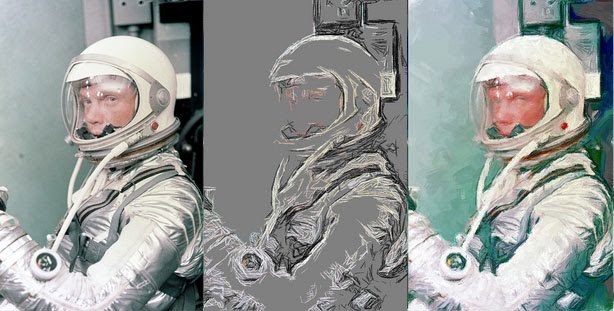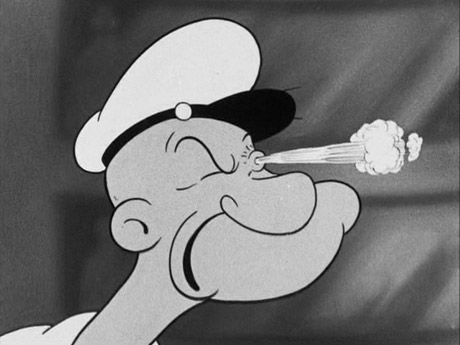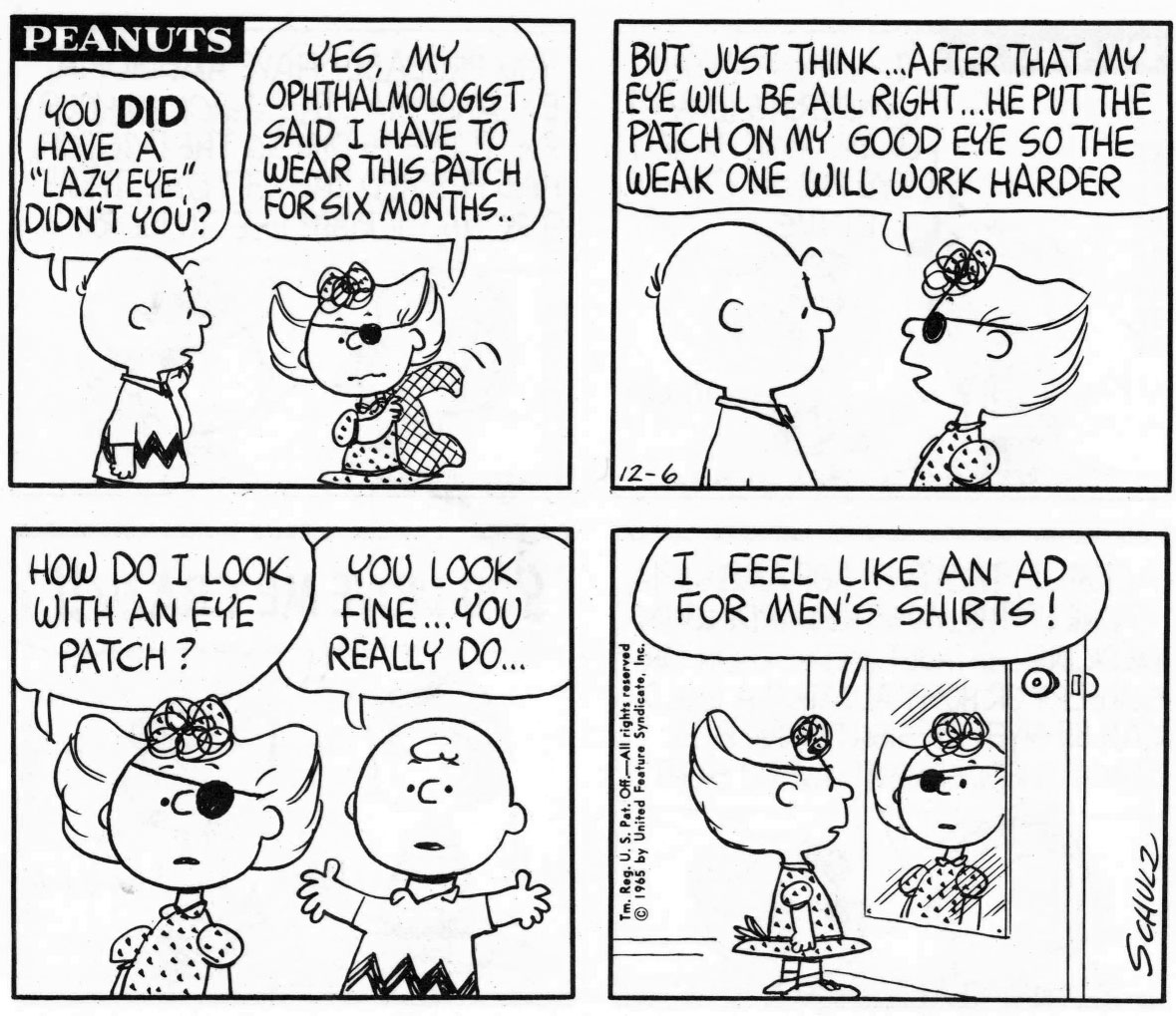Links and write-ups about beautiful things from around the web!
-
John Balestrieri’s Generative Painting Algorithms

John Balestrieri is tinkering with generative painting algorithms, trying to produce a better automated “photo -> painting” approach. You can see his works in progress on his tinrocket Flickr stream. (Yes, there are existing Photoshop / Painter filters that do similar things, but this one aims to be closer to making human-like decisions, and no, this isn’t in any way suggestive that machine-generated renderings will replace human artists – didn’t we already get over that in the age of photography?)
Whatever the utility, trying to understand the human hand in art through code is a good way to learn a lot about color theory, construction, and visual perception.
(Via Gurney Journey)
-
Michael Vorfelds Glühlampenmusik (Light Bulb Music)
Michael Vorfeld’s Glühlampenmusik, creating music through the sound of incandescent filaments popping on and off. The percussion of light and electric resistance.
(Via Make)
-
Went Digging Through My Archives and Came Across

Went digging through my archives and came across this, one of my favorite frames from the first year of the original Fleischer Brothers’ Popeye shorts. In a contest of manliness, Bluto smokes an entire cigar in one drag and blows the smoke in Popeye’s face. The sailor retaliates by doing the same but blowing the smoke out of his one good eye. This is what makes animation great, folks!
Here’s a link to the full cartoon: Can You Take It?
-
This Presents an Interesting Problem Caricature
This presents an interesting problem. Caricature has never been taken as seriously as realism. The history of Western art, with the exception of the dark ages and the 20th century, has always been derived from realism, and the art of the dark ages probably had more to do with the loss of knowledge and craft than with a conscious artistic choice. Caricature might be seen as clever, but except for artists, nobody values caricature as more than a lightweight diversion. Disney moved more towards illustration when he went into features. The all-cgi features have pushed their visuals towards greater complexity (which sometimes clashes with their character designs). Video games have also gravitated towards realism. I believe that this has been motivated by a desire to be taken more seriously by getting closer to what Western eyes value in art. From Mark Mayerson’s thoughtful post on Avatar’s use of mocap versus keyframe animation, why James Cameron and Peter Jackson can do it successfully (and artfully) but Robert Zemeckis fails at it (the zombie-eyed children of Polar Express, A Christmas Carol), and whether the rift between traditional animation and performance capture speaks to something deeper in the history of representational art.
-
Winsor Mccay‘s 1911 Animation of Little Nemo
Winsor McCay’s 1911 animation of his Little Nemo comic strip (embedded above) was selected this year by the U.S. Library of Congress to be entered as a culturally significant work in the National Film Registry (along with Michael Jackson’s Thriller, The Muppet Movie, and others). Knowing that McCay did this all himself, by hand, cranking out tens of thousands of hand-colored drawings (keep in mind he was also pioneering the field of animation, inventing techniques as he worked) in addition to his incredibly intricate newspaper work leads me to suspect he was living in an alternate stream of time than the rest of us. Incredible stuff.
(Via Cartoon Brew)
-
Pretend to Be Radiohead with This Point Cloud Instructable
Pretend to be Radiohead with this Instructable guide to 3D light scanning using a projector, camera, and a bit of Processing! This is designed to create the visualization seen in the video above, but you could also use the point data for output on a 3D printer, animation package, etc. Neat.
(Via Make)
-
Salon: The Aesthetic Gulf Between Miyazaki and Pixar
In place of the conventional, reductive versions of morality and psychology shown in Pixar’s films, Miyazaki gives us something closer to actual experience, treating good and evil not as a binary equation but as a sliding scale and presenting people (and characters) that often don’t know why they do what they do and latch on to reductive explanations at their peril. Characters can be scary and then friendly, threatening and then reassuring, honest and then misleading; they can shift identities and change shape, succumb to spells and then break out of them. […]
Parents will testify that a child who sees his or her first Miyazaki film after a steady diet of Pixar and Disney is apt to experience a perhaps troubled reaction, much deeper than “That was fun” or “I liked it.” Miyazaki challenges every preconceived notion about family entertainment that Pixar and its ilk conditions children (and adults) to have. Pixar’s very best work this decade — “The Incredibles,” “Wall-E” and “Up,” and moments of “Monsters, Inc.” and “Finding Nemo” — is wonderful; it gives children lots to see and a fair amount to feel. But Miyazaki’s work does more than that. His art is engrossing and beautiful but also challenging. He urges children to understand themselves and the world, and then shows them how. The Babysitter mesmerizes children. Grandfather changes their lives.
From Salon’s “Directors of the Decade” countdown (Pixar and Miyazaki share the #2 slot). I think it’s a bit reductive to count “Pixar” as a director (why not specifically highlight Brad Bird or Andrew Stanton’s work?), but I know what they’re getting at. Pixar represents the best storytelling in American animation and both approaches have their valid points, but it’s interesting how much stronger of a moral stamp Miyazaki has on Studio Ghibli’s output.
(Via Mayerson on Animation)
-
An AR iPhone Simulator for the iPhone
An AR iPhone simulator for the iPhone, with working controls. I can’t put it any better than this anonymous comment from the MAKE post: “Yo Dawg, i heard you like augmented reality, so we put an iphone in your iphone so you can touch while you touch.”
-
The University of Nebraska Lincoln‘s Online Cartoon Archive

The University of Nebraska-Lincoln is hosting an online collection of U.S. government-produced comic books, with full PDF downloads. Tucked away between the weirder, more off-beat stuff you’ll find some unique work from the likes of Walt Kelly, Hank Ketchum, Dr. Seuss, Charles Schulz, and more. Like this special run of Peanuts where Charlie Brown has Sally tested for amblyopia ex anopsia.
(Via Cartoon Brew)
-
Face Detection
My camera switches over to portrait-mode whenever it sees a painting or a drawing with a face in it. It stays in AUTO mode otherwise.
According to Popular Mechanics: “a chip inside the camera constantly scans the image in its viewfinder for two eyes, a nose, ears and a chin, making out up to 10 faces at a time before you’ve hit the shutter.”
I decided to test my camera—it’s a Canon Powershot SX120—to see what it decides to regard as a face.
Artist James Gurney tests out his point-and-shoot’s facial recognition chip against works of art and illustration. A mixed bag, but a good reminder that this technology is getting better and cheaper (and subtle) all the time.
